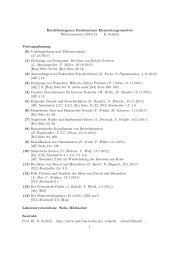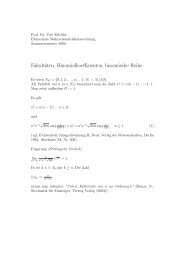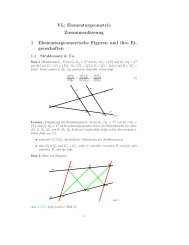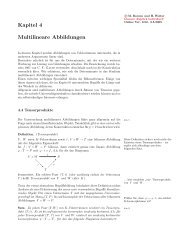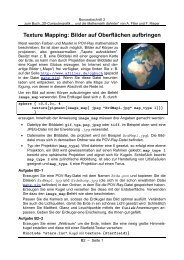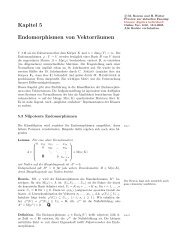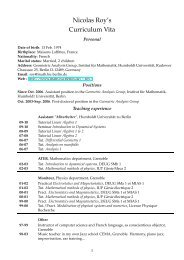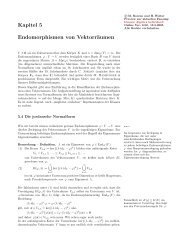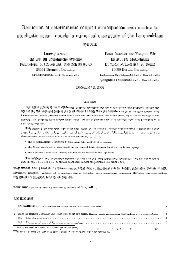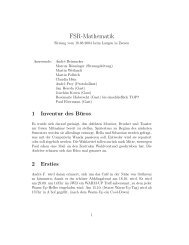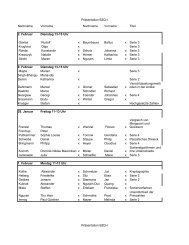MINLP Solver Software - Humboldt-Universität zu Berlin
MINLP Solver Software - Humboldt-Universität zu Berlin
MINLP Solver Software - Humboldt-Universität zu Berlin
You also want an ePaper? Increase the reach of your titles
YUMPU automatically turns print PDFs into web optimized ePapers that Google loves.
<strong>MINLP</strong> <strong>Solver</strong> <strong>Software</strong><br />
Michael R. Bussieck 1 and Stefan Vigerske 2<br />
February 21, 2012<br />
Abstract<br />
In this article we give a brief overview of the start-of-the-art in software for the solution<br />
of mixed integer nonlinear programs (<strong>MINLP</strong>). We establish several groupings with respect<br />
to various features and give concise individual descriptions for each solver. The provided<br />
information may guide the selection of a best solver for a particular <strong>MINLP</strong> problem.<br />
Keywords: mixed integer nonlinear programming, solver, software, <strong>MINLP</strong>, MIQCP<br />
1 Introduction<br />
The general form of an <strong>MINLP</strong> is<br />
minimize f(x, y)<br />
subject to g(x, y) ≤ 0 (P)<br />
x ∈ X<br />
y ∈ Y integer<br />
The function f : R n+s → R is a possibly nonlinear objective function and g : R n+s → R m<br />
a possibly nonlinear constraint function. Most algorithms require the functions f and g to<br />
be continuous and differentiable, but some may even allow for singular discontinuities. The<br />
variables x and y are the decision variables, where y is required to be integer valued. The<br />
sets X ⊆ R n and Y ⊆ R s are bounding-box-type restrictions on the variables. Additionally<br />
to integer requirements on variables, other kinds of discrete constraints are commonly used.<br />
These are, e.g., special-ordered-set constraints (only one (SOS type 1) or two consecutive<br />
(SOS type 2) variables in an (ordered) set are allowed to be nonzero) [8], semicontinuous<br />
variables (the variable is allowed to take either the value zero or a value above some bound),<br />
semiinteger variables (like semicontinuous variables, but with an additional integer restriction),<br />
and indicator variables (a binary variable indicates whether a certain set of constraints<br />
has to be enforced). In all cases it is possible to reformulate such constraints into a standard<br />
form by introducing additional variables and linear constraints. The purely continuous case<br />
(s = 0) is not considered here, c.f. the chapter titled “NLP <strong>Software</strong>” for an overview.<br />
Computational tractability depends significantly on whether the functions f(x, y) and<br />
g(x, y) are convex or not, c.f. Sec. 3.3. In this chapter, we say an <strong>MINLP</strong> is convex if both<br />
1 GAMS Development Corp., 1217 Potomac St, NW Washington, DC 20007, USA, mbussieck@gams.com<br />
2 <strong>Humboldt</strong>–<strong>Universität</strong> <strong>zu</strong> <strong>Berlin</strong>, Department of Mathematics, Unter den Linden 6, 10099 <strong>Berlin</strong>, Germany,<br />
stefan@math.hu-berlin.de<br />
1
f(x, y) and g(x, y) are convex over X × Y . Otherwise the <strong>MINLP</strong> is said to be nonconvex.<br />
Note that some solvers for convex <strong>MINLP</strong>s can also be applied under less strict notions of<br />
convexity, e.g., to the case where the set defined by the constraints g(x, y) ≤ 0 is convex, or<br />
where the objective function and constraints are only pseudo-convex [76]. (A differentiable<br />
function h : X → R is pseudo-convex on a convex set X ⊆ R n if for every x, y ∈ X with<br />
h(x) < h(y) it follows that 〈∇h(y), x − y〉 < 0. An important property of a pseudo-convex<br />
function is the convexity of its level-sets.)<br />
2 History<br />
To the best of our knowledge, the earliest commercial software package that could solve<br />
<strong>MINLP</strong> problems was SCICONIC in the mid 1970’s [7, 30, 64]. Rather than handling nonlinearities<br />
directly, linked Special-Ordered-Set variables provided a mechanism to represent<br />
low dimensional nonlinear terms by a piecewise linear approximation and thus allowed to<br />
use mixed-integer linear programming (MIP) to obtain solutions to an approximation of the<br />
<strong>MINLP</strong>. In the mid 1980’s Grossmann and Kocis developed DICOPT, a general purpose<br />
algorithm for convex <strong>MINLP</strong> based on the outer approximation method [19]. Since then, a<br />
number of academic and commercial codes for convex <strong>MINLP</strong> have emerged, either based on<br />
outer approximation using MIP relaxations [19], an integration of outer approximation into<br />
a linear programming (LP) relaxation based branch and cut [58], or nonlinear programming<br />
(NLP) relaxation based branch and bound algorithms [43]. For the global solution of nonconvex<br />
<strong>MINLP</strong>, the first general purpose solvers were alphaBB, BARON, and GLOP, all based<br />
on convexification techniques for nonconvex constraints [5, 60, 65, 67]. See also Section 3.3<br />
for a small discussion of <strong>MINLP</strong> algorithms.<br />
3 Groupings<br />
3.1 Embedded vs. independent<br />
Due to the high complexity of <strong>MINLP</strong> and the wide range of applications that can be modeled<br />
as <strong>MINLP</strong>s, it is sometimes desirable to customize the <strong>MINLP</strong> solver for a specific application<br />
in order to achieve good computational performance [12, 13, 22]. Further, <strong>MINLP</strong> solvers are<br />
often built by combining LP, MIP, and NLP solvers. These are two main reasons for tightly<br />
integrating some <strong>MINLP</strong> solvers into modeling systems (general systems like AIMMS [59],<br />
AMPL [31], and GAMS [32] or vendor specific systems like FICO Xpress-Mosel [25],<br />
LINGO [63], and OPL [17]). For example, the AIMMS Outer Approximation solver AOA<br />
allows modifications of its algorithm by the user. Further, the solvers DICOPT and SBB are<br />
exclusively available for GAMS users since they revert to MIP and NLP solvers in the GAMS<br />
system for the solution of subproblems. Also for an efficient use of the solver OQNLP it is<br />
preferable to use one of the GAMS NLP solvers.<br />
On the other side, there are many solvers that can be used independently of a modeling<br />
system, even though they may still require the presence of an LP, MIP, or NLP solver plugin.<br />
However, often also these “independent” solvers are used within a modeling system, since the<br />
modeling system typically provides evaluators for nonlinear functions, gradients, and Hessians<br />
and gives easy access to algebraic information about the problem.<br />
2
3.2 Extending MIP vs. extending NLP vs. starting from scratch<br />
<strong>MINLP</strong> solvers are seldom developed completely from scratch. In many cases, an MIP or an<br />
NLP solver builds the basis for an extension towards <strong>MINLP</strong>. <strong>Solver</strong>s which can be categorized<br />
as extending an MIP solver towards handling of nonlinear objectives and constraints are<br />
BONMIN, Couenne, CPLEX, FICO Xpress-Optimizer, FilMINT, LindoAPI without<br />
global solver option, MOSEK, and SCIP. On the other hand, solvers where an NLP solver<br />
was extended to handle integrality restrictions are bnb, FICO Xpress-SLP, fminconset,<br />
Knitro, MILANO, <strong>MINLP</strong> BB, MISQP, OQNLP, and SBB.<br />
Finally, there is a group of solvers which were more-or-less developed from scratch, but<br />
which may solve LP, MIP, NLP, or <strong>MINLP</strong> subproblems. In this category we have alphaBB,<br />
AlphaECP, AOA, BARON, DICOPT, GloMIQO, LaGO, LindoAPI, and MIDACO.<br />
3.3 Algorithms<br />
Algorithms for solving <strong>MINLP</strong>s are often build by combining algorithms from Linear Programming,<br />
Integer Programming, and Nonlinear Programming, e.g., branch and bound, outer<br />
approximation, local search, global optimization. We refer to the chapters titled “Fundamental<br />
Techniques”, “Nonlinear Programming and Global Optimization”, and “Models and<br />
Algorithms” for an introduction into these topics.<br />
Most of the solvers implement one (or several) of three algorithmic ideas to tackle <strong>MINLP</strong>s.<br />
First, there are branch and bound solvers that use NLP relaxations: alphaBB, bnb, BON-<br />
MIN (in B-BB mode), CPLEX, FICO Xpress-Optimizer, FICO Xpress-SLP (in “SLP<br />
within MIP” mode), fminconset, Knitro, LindoAPI without global solver option, MI-<br />
LANO, <strong>MINLP</strong> BB, MOSEK, and SBB. For all these solvers except alphaBB, the NLP<br />
relaxation is obtained by relaxing the integrality restriction in (P), thus it may be a nonconvex<br />
NLP. Since the NLP solver used to solve the NLP relaxation usually ensures only local<br />
optimal solutions, these solvers work as heuristics in case of a nonconvex <strong>MINLP</strong>. For the<br />
solver alphaBB, however, a convex NLP relaxation is generated by using convex underestimators<br />
for the functions f(x, y) and g(x, y) in (P). This solver can therefore be applied also<br />
to nonconvex <strong>MINLP</strong>s.<br />
As an alternative to relaxing integrality restrictions and keeping nonlinear constraints,<br />
some solvers keep the integrality constraints and instead replace the nonlinear functions<br />
f(x, y) and g(x, y) by a linear relaxation. In an outer-approximation algorithm [19, 27],<br />
a relaxation is obtained by using gradient-based linearizations of f(x, y) or g(x, y) at solution<br />
points of NLP subproblems. The resulting MIP relaxation is then solved by an MIP solver.<br />
<strong>Solver</strong>s in this class are AOA, BONMIN (in B-OA mode), DICOPT, MISQP (with OA<br />
extension), and FICO Xpress-SLP (in “MIP within SLP” mode). Since gradient-based linearizations<br />
yield an outer-approximation only for convex <strong>MINLP</strong>s, these solvers are only applicable<br />
for convex <strong>MINLP</strong>s. In contrast to outer-approximation based algorithms, an extended<br />
cutting plane algorithm solves a sequence of MIP relaxations which encapsulate optimal solutions<br />
of (P) by cutting planes and supports of f(x, y) rather than outer-approximating the<br />
whole feasible region of (P) [75]. This algorithm is implemented by the solver AlphaECP,<br />
which can be applied to convex as well as pseudo-convex <strong>MINLP</strong>s.<br />
A third class of solvers are those which integrate the linearization of f(x, y) and g(x, y)<br />
into the branch and cut process [58]. Thus, here an LP relaxation is successively solved, new<br />
linearizations of f(x, y) and g(x, y) are generated to improve the relaxation, and integrality<br />
3
constraints are enforced by branching on the y variables. <strong>Solver</strong>s which use gradient-based<br />
linearizations are AOA, BONMIN (in B-QG mode) and FilMINT.<br />
Since the use of gradient-based linearizations in a branch and cut algorithm ensures global<br />
solutions only for convex <strong>MINLP</strong>s, solvers for nonconvex <strong>MINLP</strong>s use convexification techniques<br />
to compute linear underestimators of a nonconvex function. However, the additional<br />
convexification step may require to branch also on continuous variables in nonconvex terms<br />
(so called spatial branching). Such a branch and cut algorithm is implemented by BARON,<br />
Couenne, GloMIQO, LaGO, LindoAPI, and SCIP.<br />
The remaining solvers implement a different methodology. BONMIN (in B-Hyb mode)<br />
alternates between LP and NLP relaxations during one branch and bound process. MISQP<br />
integrates the handling of integrality restrictions into the solution of a nonlinear program via<br />
sequential quadratic programming, i.e., it ensures that f(x, y) and g(x, y) are only evaluated<br />
at points where y is integral. MIDACO applies an extended ant colony optimization method<br />
and can use MISQP as a local solver. Finally, OQNLP applies a randomized approach by<br />
sampling starting points and fixings of integer variables for the solution of NLP subproblems.<br />
3.4 Capabilities<br />
Not every solver accepts general <strong>MINLP</strong>s as input. <strong>Solver</strong>s that currently handle only <strong>MINLP</strong>s<br />
where the objective function and constraints are quadratic (so-called MIQCPs) or second order<br />
cone (SOC) programs are CPLEX, FICO Xpress-Optimizer, GloMIQO, and MOSEK.<br />
All solvers support convex quadratic functions. Further, nonconvex quadratic functions that<br />
involve only binary variables are supported by CPLEX and FICO Xpress-Optimizer.<br />
Quadratic constraints that permit a SOC representation are supported by CPLEX. SOC<br />
constraints are supported by MOSEK. CPLEX and GloMIQO support quadratic constraints<br />
in any form, but CPLEX ensures global optimality only for the cases mentioned<br />
before.<br />
<strong>Solver</strong>s that guarantee global optimal solutions for convex general <strong>MINLP</strong>s are AlphaECP,<br />
AOA, bnb, BONMIN, DICOPT, FICO Xpress-SLP, FilMINT, fminconset,<br />
Knitro, LaGO, LindoAPI without global solver option, MILANO, <strong>MINLP</strong> BB, MISQP<br />
with OA extension, and SBB. In case of a nonconvex <strong>MINLP</strong>, these solvers can still be used<br />
as a heuristic. Especially branch and bound based algorithms that use NLPs for bounding<br />
often find good solutions also for nonconvex problems, while pure outer approximation based<br />
algorithms may easily run into infeasible LP or MIP relaxations due to wrong cutting planes.<br />
Note, that AlphaECP ensures global optimal solutions also for pseudo-convex <strong>MINLP</strong>s.<br />
<strong>Solver</strong>s that also guarantee global optimality for nonconvex general <strong>MINLP</strong>s require an<br />
algebraic representation of the functions f(x, y) and g(x, y) for the computation of convex underestimators.<br />
That is, for each function a representation as a composition of basic arithmetic<br />
operations and functions (addition, multiplication, power, exponential, trigonometric, ...) on<br />
constants and variables need to be provided. The solvers alphaBB, BARON, Couenne,<br />
LindoAPI, and SCIP belong into this category.<br />
MIDACO, MISQP, and OQNLP can handle general <strong>MINLP</strong>s, but do not guarantee<br />
global optimality even on convex problems.<br />
4
4 <strong>MINLP</strong> solvers<br />
In the following we briefly discuss individual solvers for <strong>MINLP</strong>s. We have excluded solvers<br />
from this list that are clearly no longer available (e.g., SCICONIC). The solvers listed below<br />
have different levels of reliability and activity with respect to development and maintenance.<br />
Wide availability through modeling systems and other popular software indicates that a solver<br />
has reached a decent level of maturity. Hence, in this list, we mention availability (e.g.,<br />
open source, standalone binary, interfaces to general modeling systems) in addition to a<br />
solver’s developer, capability, and algorithmic details. Table 1 summarizes the list of solvers<br />
and indicates for each solver the availability via AIMMS, AMPL, GAMS, and the NEOS<br />
server [16].<br />
alphaBB (α-Branch-and-Bound) [3, 5]. This solver has been developed by the research<br />
group of C. A. Floudas at the Computer-Aided Systems Laboratory of Princeton University.<br />
It is available to this group and to their collaborators.<br />
alphaBB can be applied for convex and nonconvex <strong>MINLP</strong>s. It implements a branch<br />
and bound algorithm that utilizes convex NLPs for bounding. Convex envelopes and tight<br />
convexifications are obtained for specially structured nonconvex terms (e.g., bilinear, trilinear,<br />
multilinear, univariate concave, edge concave, generalized polynomials, fractional), and αconvex<br />
underestimators for general twice continuously differentiable functions. The latter<br />
are determined by adding a non-positive convex function to the original nonconvex function<br />
such that the Hessian of the sum is guaranteed to be positive semidefinite (PSD) [4]. Various<br />
interval arithmetic based techniques for estimating rigorous bounds on the minimal eigenvalue<br />
of the Hessian of the original nonconvex function are available.<br />
AlphaECP (α-Extended Cutting Plane) [74, 76]. This solver has been developed<br />
by the research group of T. Westerlund at the Process Design and Systems Engineering<br />
Laboratory of the ˚Abo Akademi University, Finland. It is available as a commercial solver<br />
within GAMS.<br />
AlphaECP ensures global optimal solutions for convex and pseudo-convex <strong>MINLP</strong>s. It<br />
generates and successively improves an MIP outer approximation of a neighborhood of the<br />
set of optimal solutions of (P) and can solve NLP subproblems to find feasible solutions early.<br />
The MIP is here refined by linearizing nonlinear constraints at solutions of the MIP outer<br />
approximation. By shifting hyperplanes, pseudo-convex functions can also be handled.<br />
AOA (AIMMS Outer Approximation) [59]. This solver has been developed by Paragon<br />
Decision Technology. AOA is available as an “open solver” inside AIMMS. The open<br />
solver approach allows the user to customize the algorithm for a specific application.<br />
AOA ensures global optimal solutions only for convex <strong>MINLP</strong>s. It generates and successively<br />
improves an MIP outer approximation of (P) and can solve NLP subproblems to find<br />
feasible solutions early. In contrast to AlphaECP, AOA constructs an MIP outer approximation<br />
of the feasible region of (P) by linearizing nonlinear functions in solutions of NLP<br />
subproblems [19]. Since for a nonconvex constraint such a linearization may not be valid, the<br />
MIP relaxation is modified such that the corresponding hyperplane is allowed to move away<br />
from its support point. Recently, also a branch and bound algorithm that utilizes LPs for<br />
bounding [58] has been added to AOA.<br />
5
BARON (Branch-And-Reduce Optimization Navigator) [67, 68]. This solver was<br />
originally developed by the group of N.V. Sahinidis at the University of Illinois at Urbana-<br />
Champaign and is currently developed by N.V. Sahinidis at Carnegie Mellon University and<br />
M. Tawarmalani at Purdue University. It is available as a commercial solver within AIMMS<br />
and GAMS.<br />
BARON can be applied to convex and nonconvex <strong>MINLP</strong>s. It implements a spatial<br />
branch and bound algorithm that utilizes LPs for bounding. The linear outer-approximation<br />
is based on a reformulation of (P) that it constructed (by adding auxiliary variables) in a way<br />
that it contains only nonconvex terms for which a convex underestimator (or concave overestimator)<br />
is known. The algorithm is enhanced by using advanced box reduction techniques<br />
and new convexification techniques for quadratic functions [6]. Further, BARON is able to<br />
use NLP relaxations for bounding [34], even though this option is not encouraged.<br />
bnb (Branch ’n Bound) [40]. This solver has been developed by K. Kuipers of the<br />
Department of Applied Physics at the University of Groningen. It is available as Matlab [51]<br />
source.<br />
bnb ensures global optimal solutions for convex <strong>MINLP</strong>s. It implements a branch and<br />
bound algorithm utilizing nonlinear relaxations for the bounding step [43]. The NLPs are<br />
solved by the Matlab Optimization Toolbox routine fmincon.<br />
BONMIN (Basic Open-source Nonlinear Mixed Integer Programming) [11]. This<br />
open-source solver has been developed primarily by P. Bonami in a cooperation of Carnegie<br />
Mellon University and IBM Research, now at University Marseille. It is available in source<br />
code and as standalone binaries from COIN-OR (Computational Infrastructure for Operations<br />
Research) [48], has an AMPL interface, and is distributed as a free solver within GAMS.<br />
BONMIN ensures global optimal solutions only for convex <strong>MINLP</strong>s. It implements (at<br />
least) four algorithms: B-OA is an outer-approximation algorithm that generates and successively<br />
improves an MIP outer approximation of (P) [19], B-QG is a branch and bound<br />
algorithm that utilizes LPs for bounding [58], B-BB is a branch and bound algorithm that<br />
utilizes NLPs for bounding [43], and B-Hyb is a hybrid of B-QG and B-BB which alternates<br />
between LP and NLP relaxations for bounding. BONMIN is implemented on top of the MIP<br />
solver CBC [29] and can use filterSQP [28] and IPOPT [73] as NLP solvers.<br />
Couenne (Convex Over and Under ENvelopes for Nonlinear Estimation) [9]. This<br />
open-source solver has been developed primarily by P. Belotti, originally in a cooperation of<br />
Carnegie Mellon University and IBM Research, and now at Clemson University. It is available<br />
in source code and as standalone binaries from COIN-OR, has an AMPL interface, and is<br />
distributed as a free solver within GAMS.<br />
Couenne ensures global optimal solutions for convex and nonconvex <strong>MINLP</strong>s. It implements<br />
a spatial branch and bound algorithm that utilizes LPs for bounding. Similar to<br />
BARON, the linear outer-approximation is generated from a reformulation of (P). The algorithm<br />
is enhanced by box reduction techniques, disjunctive cuts, <strong>MINLP</strong> heuristics, and<br />
symmetry handling. Couenne is implemented on top of BONMIN.<br />
CPLEX [38]. This solver has been developed by CPLEX Optimization, Inc. (later acquired<br />
by ILOG and recently acquired by IBM). It is available as standalone binaries and as a<br />
6
component in many modeling systems.<br />
CPLEX can solve convex MIQCPs. For models that only have binary variables in the<br />
potentially indefinite quadratic matrices, CPLEX automatically reformulates the problem<br />
to an equivalent MIQCP with PSD matrices. It implements a branch and bound algorithm<br />
that utilizes LPs or QCPs for bounding. Recently, also an option to solve general nonconvex<br />
MIQCPs by a branch and bound algorithm that utilizes NLPs for bounding [43] has been<br />
added, but global optimality is not guaranteed for this case.<br />
DICOPT (Discrete and Continuous Optimizer) [32, 39]. This solver has been developed<br />
by the research group of I. E. Grossmann at the Engineering Research Design Center<br />
at Carnegie Mellon University. It is available as a commercial solver within GAMS.<br />
DICOPT ensures global optimal solutions for convex <strong>MINLP</strong>s. Starting with the NLP<br />
relaxation (obtained from (P) by relaxing the integer requirement on y), it alternates between<br />
solving MIP outer approximations and NLP subproblems of (P) to compute lower and upper<br />
bounds [19]. To accommodate nonconvex <strong>MINLP</strong>s, nonlinear equality constraints are relaxed<br />
by replacing them with inequalities where the linearizations of the nonlinear functions are<br />
allowed to move away from their support point by the use of slack variables and through<br />
an augmented penalty function in the MIP relaxation. Since in this case valid lower bounds<br />
cannot be obtained, the termination is based on lack of improvement in the objective of the<br />
NLP subproblem.<br />
FICO Xpress-Optimizer [26]. This solver has been developed by Dash Optimization<br />
(later acquired by FICO). It is available as standalone binaries and as a component in many<br />
modeling systems.<br />
FICO Xpress-Optimizer can solve convex MIQCPs. For models that only have binary<br />
variables in the potentially indefinite quadratic matrices, FICO Xpress-Optimizer<br />
automatically reformulates the problem to an equivalent MIQCP with PSD matrices. It<br />
implements a branch and bound algorithm that utilizes QCPs for bounding.<br />
FICO Xpress-SLP [24]. This solver has been developed by Dash Optimization (later<br />
acquired by FICO). It is available as standalone binaries and as a FICO Xpress-Mosel<br />
module [25].<br />
FICO Xpress-SLP ensures global optimal solutions for convex <strong>MINLP</strong>s. It implements<br />
three algorithms: The (default) “SLP within MIP” variant is a branch and bound algorithm<br />
that utilizes NLPs for bounding [43]. The NLP subproblems are solved by Successive Linear<br />
Programming (SLP). Solving MIPs as subproblems of the SLP algorithm leads to the “MIP<br />
within SLP” variant. It is comparable with an MIP relaxation based outer-approximation algorithm<br />
[19]. A third variant (“SLP then MIP”) solves first an NLP relaxation (by SLP), then<br />
an MIP relaxation, and finally an NLP subproblem to obtain a feasible solution to (P) [24].<br />
To accommodate also nonconvex constraints, in all variants, the hyperplanes obtained from<br />
gradient-based linearizations in SLP are allowed to move away from their support point.<br />
FilMINT (Filter-Mixed Integer Optimizer) [1]. This solver has been developed by<br />
the research groups of S. Leyffer at the Laboratory for Advanced Numerical Simulations<br />
of Argonne National Laboratory and J. T. Linderoth at the Department of Industrial and<br />
Systems Engineering of Lehigh University. It provides an AMPL interface.<br />
7
FilMINT ensures global optimal solutions only for convex <strong>MINLP</strong>s. It implements a<br />
branch and bound algorithm that utilizes LPs for bounding [58], where different strategies for<br />
choosing the linearization point for the nonlinear functions are available. Further, FilMINT<br />
includes several variants of disjunctive cutting planes for convex <strong>MINLP</strong> and a feasibility<br />
pump. FilMINT is implemented on top of the MIP solver MINTO [56] and the NLP solver<br />
filterSQP [28].<br />
fminconset [66]. This solver had been developed by I. Solberg at the Department of Engineering<br />
Cybernetics of the University of Trondheim (now NTNU). It is available as Matlab<br />
source.<br />
fminconset ensures global optimal solutions for convex <strong>MINLP</strong>s. It implements a branch<br />
and bound algorithm utilizing nonlinear relaxations for the bounding step [43]. The NLPs<br />
are solved by the Matlab Optimization Toolbox routine fmincon.<br />
GloMIQO [52, 53]. This solver has been developed by R. Misener and C. A. Floudas at the<br />
Computer-Aided Systems Laboratory of Princeton University. It is available as a commercial<br />
solver within GAMS.<br />
GloMIQO ensures global optimal solutions for convex and nonconvex MIQCPs. It implements<br />
a spatial branch-and-bound algorithm that utilizes MIPs for bounding and employs a<br />
large collection of convexification and bound tightening techniques for quadratic constraints.<br />
Knitro [15]. This solver has been developed by Ziena Optimization, Inc. It is available as<br />
standalone binary and as a component in many modeling systems.<br />
Knitro ensures global optimal solutions for convex <strong>MINLP</strong>s. <strong>MINLP</strong>s are solved by<br />
branch and bound, where both linear or nonlinear problems can be used for the bounding<br />
step [43, 58].<br />
LaGO (Lagrangian Global Optimizer) [57]. This open-source solver had been developed<br />
by the research group of I. Nowak at the Department of Mathematics of <strong>Humboldt</strong><br />
University <strong>Berlin</strong>. It is available in source code from COIN-OR and provides AMPL and<br />
GAMS interfaces.<br />
LaGO ensures global optimal solutions for convex <strong>MINLP</strong>s and nonconvex MIQCPs.<br />
It implements a spatial branch and bound algorithm utilizing a linear relaxation for the<br />
bounding step. The relaxation is obtained by linearizing convex functions, underestimating<br />
quadratic nonconvex functions, and approximating nonconvex nonquadratic functions by<br />
quadratic ones.<br />
LindoAPI [47, 45]. This solver library has been developed by LINDO Systems, Inc. It<br />
is available within the LINDO environment [47], LINGO [63], What’sBest! [46], and as a<br />
commercial solver within GAMS.<br />
LindoAPI ensures global optimal solutions for convex and nonconvex <strong>MINLP</strong>s. It implements<br />
a branch and cut algorithm that utilizes LPs for bounding [33, 45]. Branching is<br />
performed for subproblems that are not provably infeasible and where nonconvex constraints<br />
are present or the LP relaxation has a fractional solution. LindoAPI can also handle some<br />
nonsmooth or discontinuous functions like abs(x), floor(x), and max(x,y).<br />
8
Additionally, LindoAPI allows to disable the global solver components, by what the<br />
MIP solver is used together with nonlinear relaxations for the bounding step [43]. This<br />
option still ensures global optimal solutions for convex <strong>MINLP</strong>s. It was the first commercially<br />
available solver implementing a branch and bound algorithm utilizing nonlinear relaxations<br />
for bounding. The NLP relaxations are solved by CONOPT [18, 32].<br />
MIDACO (Mixed Integer Distributed Ant Colony Optimization) [61, 62]. This<br />
solver has been developed by M. Schlüter at the Theoretical & Computational Optimization<br />
Group of the University of Birmingham. It works as a library with Matlab, C/C++, and<br />
Fortran interfaces and is available from the author on request.<br />
MIDACO can be applied to convex and nonconvex <strong>MINLP</strong>s. It implements an extended<br />
ant colony search method based on an oracle penalty function and can be combined with<br />
MISQP as solver for local searches in (P). It targets applications where the problem formulation<br />
is unknown (f(x, y) and g(x, y) are black-box functions) or involves critical properties<br />
like nonconvexities, discontinuities, flat spots, or stochastic distortions. Further, MIDACO<br />
can exploit distributed computer architectures by parallelizing function evaluation calls.<br />
MILANO (Mixed-Integer Linear and Nonlinear Optimizer) [10]. This solver is<br />
developed by H. Y. Benson at the Department of Decision Sciences of Drexel University. It<br />
is still in development and available as Matlab source.<br />
MILANO ensures global optimal solutions for convex <strong>MINLP</strong>s. It implements a branch<br />
and bound algorithm utilizing nonlinear relaxations for the bounding step [43]. The NLPs are<br />
solved by LOQO [70], where special emphasis is put on how to warmstart this interior-point<br />
solver.<br />
<strong>MINLP</strong> BB (Mixed Integer Nonlinear Programming Branch-and-Bound) [43].<br />
This solver had been developed by R. Fletcher and S. Leyffer at the University of Dundee.<br />
It provides an AMPL interface and is available for Matlab via the TOMLAB Optimization<br />
Environment [37].<br />
<strong>MINLP</strong> BB ensures global optimal solutions for convex <strong>MINLP</strong>s. It implements a branch<br />
and bound algorithm utilizing nonlinear relaxations for the bounding step [43]. The NLPs<br />
are solved by filterSQP.<br />
MISQP (Mixed Integer Sequential Quadratic Programming) [20, 21]. This solver<br />
has been developed by the research group of K. Schittkowski at the Department of Computer<br />
Science of the University of Bayreuth. It works as a standalone library with a Fortran<br />
interface.<br />
MISQP can be applied to convex and nonconvex <strong>MINLP</strong>s, but assumes that the values of<br />
f(x, y) and g(x, y) do not change drastically as a function of y. MISQP implements a modified<br />
sequential quadratic programming (SQP) method, where functions are only evaluated at<br />
points (x, y) with y integer. It targets applications where the evaluation of f(x, y) or g(x, y)<br />
may be expensive. Additionally, a combination with outer-approximation [19] that guarantees<br />
convergence for convex <strong>MINLP</strong>s is available [41].<br />
MOSEK [55]. This solver has been developed by MOSEK ApS. It is available as a standalone<br />
binary, has AMPL and Matlab interfaces, and is distributed as a commercial solver<br />
9
within AIMMS and GAMS.<br />
MOSEK can be applied to convex MIQCPs and to mixed-integer conic programs. It implements<br />
a branch and bound method that utilizes QCPs or SOC programs for bounding [58].<br />
OQNLP (OptQuest Nonlinear Programming) [32, 69]. This solver has been jointly<br />
developed by OptTek Systems, Inc. and Optimal Methods, Inc. It is available as a standalone<br />
library, for Matlab via the TOMLAB Optimization Environment, and is distributed as a<br />
commercial solver within GAMS.<br />
OQNLP is a heuristic that can be applied to any <strong>MINLP</strong>. It implements a multistart<br />
scatter search algorithm which solves NLP subproblems with fixed discrete variables.<br />
SBB (Simple Branch-and-Bound) [32]. This solver had been developed by ARKI Consulting<br />
and Development A/S. It is available as a commercial solver within GAMS.<br />
SBB ensures global optimal solutions for convex <strong>MINLP</strong>s. It implements a branch and<br />
bound algorithm utilizing nonlinear relaxations for the bounding step [43]. The NLP relaxations<br />
are solved by one (or several) of the NLP solvers available with GAMS. Using the<br />
GAMS Branch-Cut-and-Heuristic facility [13], SBB allows the user to implement a modelspecify<br />
heuristic in the GAMS language.<br />
SCIP (Solving Constraint Integer Programs) [2, 72]. This solver has been developed<br />
by the Optimization Department at the Zuse Institute <strong>Berlin</strong> and its collaborators. For<br />
academic institutions, it is available in source code and as standalone binary and is distributed<br />
within GAMS.<br />
SCIP ensures global optimal solutions for convex and nonconvex <strong>MINLP</strong>s. It implements<br />
a spatial branch and bound algorithm that utilizes LPs for the bounding step. Similar to<br />
BARON, the outer-approximation is generated from a reformulation of the <strong>MINLP</strong>. Additionally,<br />
SCIP includes large-neighborhood search heuristics and a new sub-MIP <strong>MINLP</strong><br />
heuristic.<br />
5 Outlook and Summary<br />
Combining discrete and nonlinear optimization results in a rich modeling paradigm applicable<br />
to many real world optimization problems. At the same time, mixed integer nonlinear<br />
programming represents a theoretically and computationally challenging problem class and<br />
hence provides many interesting research opportunities. <strong>Software</strong> for solving <strong>MINLP</strong> models<br />
facilitates co-operation between research and application and explains the popularity and<br />
increased level of activity around <strong>MINLP</strong>.<br />
While state-of-the-art MIP solvers typically implement advanced automatic reformulation<br />
and preprocessing algorithms, such techniques are less commonly available in <strong>MINLP</strong><br />
solvers, and in a limited form. Therefore, the modeler’s choice of problem formulation is<br />
still very important when solving an <strong>MINLP</strong>. However, software for guided automatic model<br />
reformulations and relaxations has recently been developed. LogMIP [71], one of the first<br />
systems available, translates an <strong>MINLP</strong> with disjunctions into a standard <strong>MINLP</strong> by applying<br />
bigM and convex hull reformulations [36]. More recently, frameworks like GAMS/EMP (Extended<br />
Mathematical Programming) [23] and ROSE (Reformulation/Optimization <strong>Software</strong><br />
Engine) [44] provide a growing toolbox for reformulating <strong>MINLP</strong>s. Other recent activities,<br />
10
like libMC [54] and parts of MINOTAUR (Mixed-Integer Nonconvex Optimization Toolbox<br />
– Algorithms, Underestimators, Relaxations) [50, 49] focus on (convex) relaxations for<br />
(nonconvex) <strong>MINLP</strong>.<br />
Another important area is the collection and dissemination of <strong>MINLP</strong> models. Instance<br />
collections like Mac<strong>MINLP</strong> [42] and <strong>MINLP</strong>Lib [14] provide valuable test cases for solver<br />
developers. The new Cyber-Infrastructure for <strong>MINLP</strong> [35] features a growing library of<br />
problems with high level model descriptions, reformulations, and problem instances.<br />
In this paper we have given a concise description of the state-of-the-art in <strong>MINLP</strong> solvers<br />
and have established several groupings with respect to various features of the software. We<br />
hope that these groupings and the individual descriptions give sufficient information to guide<br />
the selection of the best solver for a particular <strong>MINLP</strong> problem.<br />
Acknowledgments. We thank Oliver Bastert, Pietro Belotti, Zsolt Csizmadia, Steve Dirkse,<br />
Arne Drud, Christodoulos Floudas, Ignacio Grossmann, Marcel Hunting, Ed Klotz, Nikolaos<br />
Sahinidis, Martin Schlüter, Linus Schrage, and Tapio Westerlund for their invaluable<br />
comments. The second author was supported by the DFG Research Center Matheon Mathematics<br />
for key technologies in <strong>Berlin</strong>.<br />
References<br />
[1] K. Abhishek, S. Leyffer, and J.T. Linderoth. FilMINT: An outer-approximationbased<br />
solver for nonlinear mixed integer programs. INFORMS Journal On Computing,<br />
22(4):555–567, 2010.<br />
[2] T. Achterberg. SCIP: Solving Constraint Integer Programs. Mathematical Programming<br />
Computation, 1(1):1–41, 2009.<br />
[3] C.S. Adjiman, I.P. Androulakis, and C.A. Floudas. Global optimization of mixed-integer<br />
nonlinear problems. Journal of the American Institute of Chemical Engineers, 46:1769–<br />
1797, 2000.<br />
[4] C.S. Adjiman and C.A. Floudas. Rigorous convex underestimators for general twicedifferentiable<br />
problems. Journal of Global Optimization, 9:23–40, 1996.<br />
[5] I.P. Androulakis, C.D. Maranas, and C.A. Floudas. αBB: A global optimization method<br />
for general constrained nonconvex problems. Journal of Global Optimization, 7:337–363,<br />
1995.<br />
[6] X. Bao, N.V. Sahinidis, and M. Tawarmalani. Multiterm polyhedral relaxations for<br />
nonconvex, quadratically-constrained quadratic programs. Optimization Methods and<br />
<strong>Software</strong>, 24:485–504, 2009.<br />
[7] E.M.L. Beale. Branch and bound methods for numerical optimization of non-convex<br />
functions. In M.M. Barritt and D. Wishart, editors, COMPSTAT 80 Proceedings in<br />
Computational Statistics, pages 11–20, Vienna, 1980. Physica-Verlag.<br />
[8] E.M.L. Beale and J.A. Tomlin. Special Facilities in a General Mathematical Programming<br />
System for Nonconvex Problems Using Ordered Sets of Variables, pages 447–454.<br />
Number 69 in Operational Research. Tavistock Publishing, London, 1970.<br />
11
[9] P. Belotti, J. Lee, L. Liberti, F. Margot, and A. Wächter. Branching and bounds tightening<br />
techniques for non-convex <strong>MINLP</strong>. Optimization Methods and <strong>Software</strong>, 24(4-5):597–<br />
634, 2009.<br />
[10] H. Y. Benson. Mixed integer nonlinear programming using interior-point methods. Optimization<br />
Methods and <strong>Software</strong>, 26(6):911–931, 2011.<br />
[11] P. Bonami, L.T. Biegler, A.R. Conn, G. Cornuéjols, I.E. Grossmann, C.D. Laird, J. Lee,<br />
A. Lodi, F. Margot, N. Sawaya, and A. Wächter. An algorithmic framework for convex<br />
mixed integer nonlinear programs. Discrete Optimization, 5:186–204, 2008.<br />
[12] C. Bragalli, C. D’Ambrosio, J. Lee, A. Lodi, and P. Toth. On the optimal design of water<br />
distribution networks: a practical <strong>MINLP</strong> approach. Optimization and Engineering, to<br />
appear, 2011.<br />
[13] M.R. Bussieck. Introduction to GAMS Branch-and-Cut Facility. Technical report, GAMS<br />
Development Corp., 2003. http://www.gams.com/docs/bch.htm.<br />
[14] M.R. Bussieck, A.S. Drud, and A. Meeraus. <strong>MINLP</strong>Lib - A Collection of Test Models for<br />
Mixed-Integer Nonlinear Programming. INFORMS Journal on Computing, 15(1):114–<br />
119, 2003.<br />
[15] R.H. Byrd, J. Nocedal, and R.A. Waltz. KNITRO: An integrated package for nonlinear<br />
optimization. In G. di Pillo and M. Roma, editors, Large-Scale Nonlinear Optimization,<br />
pages 35–59. Springer, 2006.<br />
[16] J. Czyzyk, M. Mesnier, and J. Moré. The NEOS server. IEEE Journal on Computational<br />
Science and Engineering, 5:68–75, 1998. http://neos.mcs.anl.gov.<br />
[17] T. Dong. Efficient modeling with the IBM ILOG OPL-CPLEX Development<br />
Bundles. http://www-01.ibm.com/software/integration/optimization/<br />
cplex-dev-bundles/library, 2009.<br />
[18] A. Drud. CONOPT - a large-scale GRG code. INFORMS Journal on Computing, 6:207–<br />
216, 1992.<br />
[19] M.A. Duran and I.E. Grossmann. An outer-approximation algorithm for a class of mixedinteger<br />
nonlinear programs. Mathematical Programming, 36:307–339, 1986.<br />
[20] O. Exler, T. Lehmann, and K. Schittkowski. A comparative study of SQP-type algorithms<br />
for nonlinear and nonconvex mixed-integer optimization. http://www.ai7.<br />
uni-bayreuth.de/minlp_comp_study.htm, 2011.<br />
[21] O. Exler and K. Schittkowski. A trust region SQP algorithm for mixed-integer nonlinear<br />
programming. Optimization Letters, 1(3):269–280, 2007.<br />
[22] T. Farkas, B. C<strong>zu</strong>czai, E. Rev, and Z. Lelkes. New <strong>MINLP</strong> model and modified outer<br />
approximation algorithm for distillation column synthesis. Industrial & Engineering<br />
Chemistry Research, 47:3088–3103, 2008.<br />
12
[23] M.C. Ferris, S.P. Dirkse, J.-H. Jagla, and A. Meeraus. An extended mathematical programming<br />
framework. Computers & Chemical Engineering, 33(12):1973–1982, 2009. FO-<br />
CAPO 2008 - Selected Papers from the Fifth International Conference on Foundations<br />
of Computer-Aided Process Operations.<br />
[24] FICO. Xpress-SLP Program Reference Manual, 1.41 edition, 2008. http://www.fico.<br />
com/xpress.<br />
[25] FICO. Xpress-Mosel 7.0, 2009. http://www.fico.com/xpress.<br />
[26] FICO. Xpress-Optimizer Reference manual, 20.0 edition, 2009. http://www.fico.com/<br />
xpress.<br />
[27] R. Fletcher and S. Leyffer. Solving Mixed Integer Nonlinear Programs by Outer Approximation.<br />
Mathematical Programming, 66(3):327–349, 1994.<br />
[28] R. Fletcher and S. Leyffer. Nonlinear programming without a penalty function. Mathematical<br />
Programming, 91:239–270, 2002.<br />
[29] J.J.H. Forrest. COIN-OR Branch and Cut. http://projects.coin-or.org/Cbc.<br />
[30] J.J.H. Forrest and J.A. Tomlin. Branch and bound, integer, and non-integer programming.<br />
Annals of Operations Research, 149(1):81–87, 2007.<br />
[31] R. Fourer, D.M. Gay, and B.W. Kernighan. AMPL: A Modeling Language for Mathematical<br />
Programming. Duxbury Press, Brooks/Cole Publishing Company, 1993.<br />
[32] GAMS Development Corp. GAMS – The <strong>Solver</strong> Manuals. Washington DC, 2011.<br />
[33] C. Gau and L. Schrage. Implementation and testing of a branch-and-bound based method<br />
for deterministic global optimization: Operations research applications. In C.A. Floudas<br />
and P.M. Pardalos, editors, Frontiers in Global Optimization, Nonconvex Optimization<br />
and Its Applications, pages 145–164. Springer, 2003.<br />
[34] V. Ghildyal and N.V. Sahinidis. Solving global optimization problems with BARON.<br />
In A. Migdalas, P.M. Pardalos, and P. Värbrand, editors, From Local to Global Optimization,<br />
volume 53 of Nonconvex Optimization and Its Applications, chapter 10, pages<br />
205–230. Springer, 2001.<br />
[35] I. E. Grossmann and J. Lee. Cyberinfrastructure for mixed-integer nonlinear programming.<br />
SIAG/OPT Views-and-News, 22(1):8–12, March 2011.<br />
[36] I. E. Grossmann and S. Lee. Generalized disjunctive programming: Nonlinear convex hull<br />
relaxation and algorithms. Computational Optimization and Applications, (26):83–100,<br />
2003.<br />
[37] K. Holmström. The Tomlab Optimization Environment in Matlab. Advanced Modeling<br />
and Optimization, 1:47–69, 1999. http://tomopt.com/tomlab.<br />
[38] IBM. CPLEX. http://www.ibm.com/software/integration/optimization/cplex.<br />
13
[39] G.R. Kocis and I.E. Grossmann. Computational experience with DICOPT: Solving<br />
<strong>MINLP</strong> problems in process systems engineering. Computers & Chemical Engineering,<br />
13:307–315, 1989.<br />
[40] K. Kuipers. bnb. http://www.mathworks.com/matlabcentral/fileexchange/95,<br />
2003.<br />
[41] T. Lehmann. On Efficient Solution Methods for Mixed-Integer Nonlinear and Mixed-<br />
Integer Quadratic Optimization Problems. PhD thesis, <strong>Universität</strong> Bayreuth, 2011.<br />
[42] S. Leyffer. Mac<strong>MINLP</strong>. http://wiki.mcs.anl.gov/leyffer/index.php/Mac<strong>MINLP</strong>.<br />
[43] S. Leyffer. Integrating SQP and branch-and-bound for mixed integer nonlinear programming.<br />
Computational Optimization and Applications, 18:295–309, 2001.<br />
[44] L. Liberti, S. Cafieri, and F. Tarissan. Reformulations in mathematical programming:<br />
A computational approach. In A. Abraham, A.-E. Hassanien, and P. Siarry, editors,<br />
Global Optimization, volume 203 of Studies in Computational Intelligence, pages 153–<br />
234. Springer, New York, 2009.<br />
[45] Y. Lin and L. Schrage. The global solver in the LINDO API. Optimization Methods &<br />
<strong>Software</strong>, 24(4–5):657–668, 2009.<br />
[46] Lindo Systems, Inc. What’sBest! 10.0, 2009. http://www.lindo.com.<br />
[47] Lindo Systems, Inc. Lindo API 6.1, 2010. http://www.lindo.com.<br />
[48] R. Lougee-Heimer. The Common Optimization INterface for Operations Research. IBM<br />
Journal of Research and Development, 47(1):57–66, 2003. http://www.coin-or.org.<br />
[49] A. Mahajan. Global optimization with MINOTAUR. talk at INFORMS Annual Meeting,<br />
November 2011.<br />
[50] A. Mahajan and T. Munson. Exploiting second-order cone structure for global optimization.<br />
Technical Report ANL/MCS-P1801-1010, Argonne National Laboratory, 2010.<br />
[51] The MathWorks. MATLAB User’s Guide, 2009. http://www.mathworks.com.<br />
[52] R. Misener and C. A. Floudas. Global optimization of mixed-integer quadraticallyconstrained<br />
quadratic programs (MIQCQP) through piecewise-linear and edge-concave<br />
relaxations. Accepted for Mathematical Programming, 2011.<br />
[53] R. Misener and C. A. Floudas. GloMIQO: Global mixed-integer quadratic optimizer.<br />
Accepted for Journal of Global Optimization, 2012.<br />
[54] A. Mitsos, B. Chachuat, and P.I. Barton. McCormick-based relaxations of algorithms.<br />
SIAM Journal on Optimization, 20(2):573–601, 2009.<br />
[55] MOSEK Corporation. The MOSEK optimization tools manual, 6.0 edition, 2009. http:<br />
//www.mosek.com.<br />
[56] G.L. Nemhauser, M.W.P. Savelsbergh, and G.S. Sigismondi. MINTO, a Mixed INTeger<br />
Optimizer. Operations Research Letters, 15:47–58, 1994.<br />
14
[57] I. Nowak and S. Vigerske. LaGO: a (heuristic) branch and cut algorithm for nonconvex<br />
<strong>MINLP</strong>s. Central European Journal of Operations Research, 16(2):127–138, 2008.<br />
[58] L. Quesada and I.E. Grossmann. An LP/NLP based branch and bound algorithm for<br />
convex <strong>MINLP</strong> optimization problems. Computers & Chemical Engineering, 16:937–947,<br />
1992.<br />
[59] M. Roelofs and J. Bisschop. AIMMS 3.9 – The Language Reference. Paragon Decision<br />
Technology B.V., Haarlem, The Netherlands, 2009.<br />
[60] N.V. Sahinidis. BARON: A general purpose global optimization software package. Journal<br />
of Global Optimization, 8(2):201–205, 1996.<br />
[61] M. Schlüter and M. Gerdts. The oracle penalty method. Journal of Global Optimization,<br />
47(2):293–325, 2009.<br />
[62] M. Schlüter, M. Gerdts, and J.J. Rückmann. MIDACO: New global optimization software<br />
for <strong>MINLP</strong>. available at http://www.midaco-solver.com/about.html, 2010.<br />
[63] L. Schrage. Optimization Modeling with LINGO. Lindo Systems, Inc., 2008. http:<br />
//www.lindo.com.<br />
[64] SCICON Ltd. SCICONIC User Guide Version 1.40. Scicon Ltd., Milton Keynes, UK,<br />
1989.<br />
[65] E.M.B. Smith and C.C. Pantelides. A symbolic reformulation/spatial branch-and-bound<br />
algorithm for the global optimization of nonconvex <strong>MINLP</strong>s. Computers & Chemical<br />
Engineering, 23:457–478, 1999.<br />
[66] I. Solberg. fminconset. http://www.mathworks.com/matlabcentral/fileexchange/<br />
96.<br />
[67] M. Tawarmalani and N.V. Sahinidis. Convexification and Global Optimization in Continuous<br />
and Mixed-Integer Nonlinear Programming: Theory, Algorithms, <strong>Software</strong>, and<br />
Applications. Kluwer Academic Publishers, 2002.<br />
[68] M. Tawarmalani and N.V. Sahinidis. Global optimization of mixed-integer nonlinear<br />
programs: A theoretical and computational study. Mathematical Programming, 99:563–<br />
591, 2004.<br />
[69] Z. Ugray, L. Lasdon, J. Plummer, F. Glover, J. Kelly, and R. Martí. Scatter search and<br />
local NLP solvers: A multistart framework for global optimization. INFORMS Journal<br />
on Computing, 19(3):328–340, 2007.<br />
[70] R.J. Vanderbei and D.F. Shanno. An interior-point algorithm for nonconvex nonlinear<br />
programming. Computational Optimization and Applications, 13:231–252, 1999.<br />
[71] A. Vecchietti and I.E. Grossmann. LOGMIP: A Disjunctive 0-1 Nonlinear Optimizer for<br />
Process System Models. Computers & Chemical Engineering, 23:555–565, 1999.<br />
[72] S. Vigerske. Decomposition of Multistage Stochastic Programs and a Constraint Integer<br />
Programming Approach to Mixed-Integer Nonlinear Programming. PhD thesis, <strong>Humboldt</strong><br />
<strong>Universität</strong> <strong>zu</strong> <strong>Berlin</strong>, 2012. Submitted.<br />
15
[73] A. Wächter and L.T. Biegler. On the implementation of a primal-dual interior point filter<br />
line search algorithm for large-scale nonlinear programming. Mathematical Programming,<br />
106(1):25–57, 2006. http://projects.coin-or.org/Ipopt.<br />
[74] T. Westerlund and K. Lundquist. Alpha-ECP, version 5.04. an interactive <strong>MINLP</strong>solver<br />
based on the extended cutting plane method. Technical Report 01-178-A, Process<br />
Design Laboratory, ˚Abo Akademi University, ˚Abo, Finland, 2003. http://www.abo.fi/<br />
~twesterl/A-ECPManual.pdf.<br />
[75] T. Westerlund and F. Pettersson. An extended cutting plane method for solving convex<br />
<strong>MINLP</strong> problems. Computers & Chemical Engineering, 19:S131–S136, 1995.<br />
[76] T. Westerlund and R. Pörn. Solving pseudo-convex mixed integer optimization problems<br />
by cutting plane techniques. Optimization and Engineering, 3:253–280, 2002.<br />
16
solver literature AIMMS AMPL GAMS NEOS URL<br />
CPLEX [38] � � � – http://www-01.ibm.com/software/integration/optimization/cplex<br />
FICO Xpress-Optimizer [26] � � � – http://www.fico.com/xpress<br />
GloMIQO [52, 53] – – � – http://helios.princeton.edu/GloMIQO<br />
MOSEK [55] � � � – http://www.mosek.com<br />
MIQCP<br />
alphaBB [3, 5] – – – – http://titan.princeton.edu<br />
AlphaECP [74, 76] – – � � http://www.abo.fi/~twesterl<br />
AOA [59] � – – – http://www.aimms.com<br />
BARON [67, 68] � – � � http://archimedes.cheme.cmu.edu/baron/baron.html<br />
bnb [40] – – – – http://www.mathworks.com/matlabcentral/fileexchange/95<br />
BONMIN [11] – � � � https://projects.coin-or.org/Bonmin<br />
Couenne [9] – � � � https://projects.coin-or.org/Couenne<br />
DICOPT [32, 39] – – � � http://www.gams.com/solvers<br />
FICO Xpress-SLP [24] – – – – http://www.fico.com/xpress<br />
FilMINT [1] – � – � http://www.neos-server.org/neos/solvers/minco:FilMINT/AMPL.html<br />
fminconset [66] – – – – http://www.mathworks.com/matlabcentral/fileexchange/96<br />
Knitro [15] � � � � http://www.ziena.com<br />
LaGO [57] – � �a – https://projects.coin-or.org/LaGO<br />
LindoAPI [47, 45] – – � � http://www.lindo.com<br />
LogMIP [71] – – � – http://www.logmip.ceride.gov.ar<br />
MIDACO [61, 62] – – – – http://www.midaco-solver.com<br />
MILANO [10] – – – – http://www.pages.drexel.edu/~hvb22/milano<br />
<strong>MINLP</strong> BB [43] – � – � http://wiki.mcs.anl.gov/leyffer/index.php/Sven_Leyffer’s_<strong>Software</strong>#<strong>MINLP</strong>BB<br />
MISQP [20, 21] – – – – http://www.klaus-schittkowski.de/misqp.htm<br />
OQNLP [32, 69] – – � � http://www.gams.com/solvers<br />
SBB [32] – – � � http://www.gams.com/solvers<br />
SCIP [2, 72] – – � � http://scip.zib.de<br />
general <strong>MINLP</strong><br />
17<br />
Table 1: An overview on solvers for <strong>MINLP</strong>. The first row indicates whether a solver accepts only problems with quadratic functions<br />
(MIQCPs) or general nonlinear functions (<strong>MINLP</strong>s).<br />
a interface for <strong>MINLP</strong>s available, but not included in GAMS distribution



